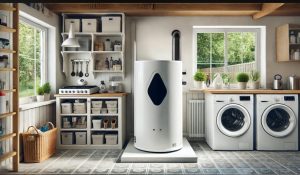 Hybrid heat pumps are gaining popularity as a versatile and efficient heating solution that combines the benefits of traditional fossil fuel-based systems with renewable energy-based heat pumps. These systems are designed to maximise energy efficiency, reduce carbon emissions, and provide consistent heating by switching between the two sources depending on outdoor conditions. But where do hybrid heat pumps work best: in retrofits or new builds? Let’s explore.
Hybrid heat pumps are gaining popularity as a versatile and efficient heating solution that combines the benefits of traditional fossil fuel-based systems with renewable energy-based heat pumps. These systems are designed to maximise energy efficiency, reduce carbon emissions, and provide consistent heating by switching between the two sources depending on outdoor conditions. But where do hybrid heat pumps work best: in retrofits or new builds? Let’s explore.
What is a Hybrid Heat Pump?
A hybrid heat pump integrates a traditional heating system, such as a gas or oil boiler, with a renewable energy-based heat pump, such as an air or ground source heat pump. This combination allows the system to use the most efficient energy source based on the current temperature, optimising energy use and reducing costs.
Key Features and Benefits
Energy Efficiency: Hybrid heat pumps maximise efficiency by using the heat pump when temperatures are moderate and switching to the boiler when it gets too cold.
Cost Savings: They reduce energy bills by optimising the use of renewable energy.
Reduced Carbon Emissions: They lower reliance on fossil fuels, helping to achieve sustainability goals.
Consistent Comfort: They ensure a reliable and consistent heating supply, adjusting automatically to maintain comfort.
Flexibility: They can be integrated into existing heating systems, making them versatile.
Advanced Control: Many systems offer automation and remote management for optimal performance.
Hybrid Heat Pumps in Retrofits
Advantages:
Compatibility with Existing Systems: Hybrid heat pumps can be integrated with existing heating setups, making them an excellent choice for upgrading older homes without extensive modifications.
Cost-Effective: Retrofitting a hybrid heat pump can be more affordable than installing a new system, as it uses existing infrastructure.
Efficiency Improvement: They can significantly enhance energy efficiency and reduce heating costs in older buildings with less efficient systems.
Flexibility: They provide a solution for homes that are unsuitable for standalone heat pumps due to insulation or space limitations.
Considerations:
Assessment Needed: To ensure compatibility and optimal performance, a thorough evaluation of the existing system and the building’s insulation is necessary.
Installation Complexity: The installation can be more complex and may require adjustments to the current system.
Hybrid Heat Pumps in New Builds
Advantages:
Optimal Design Integration: New builds can be designed with a hybrid heat pump system in mind, ensuring optimal integration and efficiency from the start.
Modern Standards: New homes often meet higher insulation and energy efficiency standards, enhancing the performance of hybrid heat pumps.
Future-Proofing: Installing a hybrid heat pump aligns with future energy efficiency standards and sustainability goals.
Lower Operating Costs: With better insulation and modern construction techniques, new builds can maximise the benefits of hybrid heat pumps, leading to lower operating costs.
Considerations:
Initial Cost: The initial installation cost can be higher than traditional systems, though long-term savings and efficiency gains often offset this.
Conclusion
Hybrid heat pumps offer a flexible, efficient, and sustainable heating solution suitable for retrofits and new builds.
Retrofits are ideal for improving energy efficiency and reducing costs in existing homes with older systems. They provide a practical upgrade without significant structural changes.
New Builds: They offer the best opportunity to maximise energy efficiency and sustainability from the outset, with the ability to design the home around the hybrid system for optimal performance.
Whether you are looking to upgrade your current heating system or planning a new construction project, hybrid heat pumps present a compelling option. They balance immediate needs with long-term benefits.

Leave a Reply